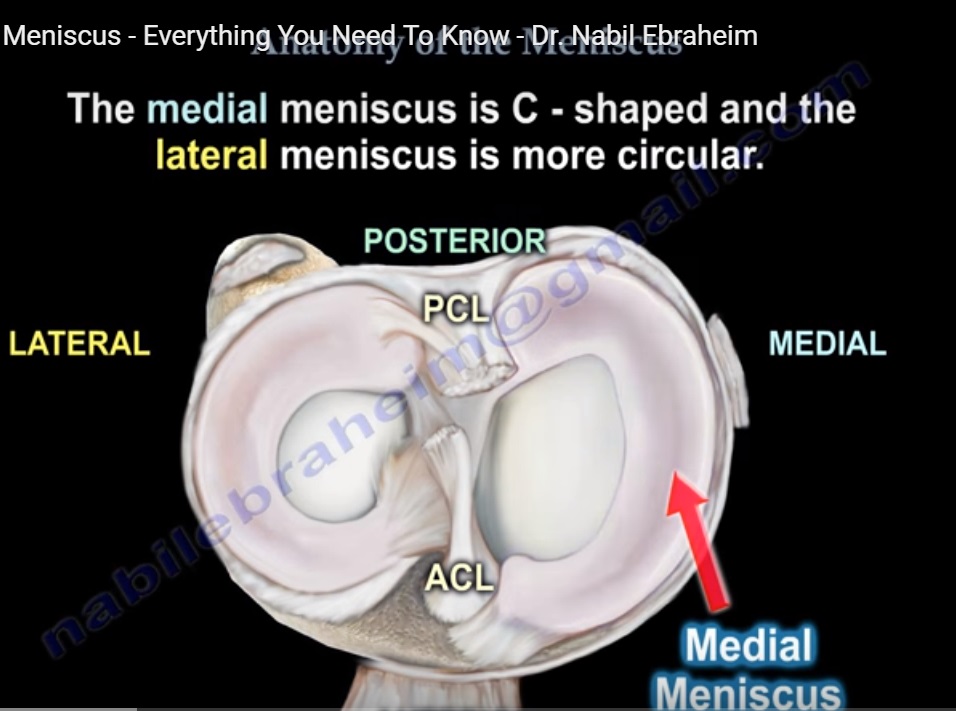Courtesy: Prof Nabile Ebraheim, University of TOledo, Ohio, USA
ANATOMY OF MENISCUS
The meniscus is a cushion like structure made of cartilage which fits within the knee joint between the tibia and femur.
There are two menisci inside the knee joint:
1. Medial meniscus
2. Lateral meniscus
- Medial meniscus is C shaped and the lateral meniscus is more circular .The medial meniscus covers 50% of the medial tibial plateau and the lateral meniscus covers 70% of the lateral tibial plateau.
- With the medial meniscus, the anterior and posterior horns are separated from each other and from the anterior cruciate ligament. The posterior horn of the medial meniscus is the main secondary stabiliser of anterior translation.
- The anterior and posterior horns of the lateral meniscus are closer to each other and near the insertion of the ACL .The transverse intermeniscal ligament connects the anterior horns of the lateral and medial menisci.
- The meniscus is made up of type I collagen . The meniscus provides shock absorption and stability to the knee joint . The meniscus provides load sharing across the knee by increasing the contact area and decreasing the contact stress.
- If the meniscus is removed the patient will develop arthritis of the knee joint .The contact stress increases 2-3 times when the meniscus is removed. The stress increases with the increased loss of meniscal tissue .
- The meniscus helps to protect the knee joint, allowing the bones to slide freely on each other, however the meniscus limits flexion and extension extremes.
- The meniscus transmits 50 degrees of force in extension and 90 degrees of force in flexion .Beyond 90 degrees , most of the force is transmitted to the posterior horn of the meniscus (flexion of the knee causes pain).
BLOOD SUPPLY
- The blood supply of the meniscus decides the healing potential of the meniscus.
- The peripheral 1/3 of the meniscus is vascular
- It will heal if repaired
- The inner 1/3 of the meniscus is not vascular and is nourished by synovial fluid
- The middle third is red/white and it is avascular
- The blood supply of the meniscus originates from the medial and lateral genicular arteries
- The meniscus appears triangular in a cross section.
Traumatic tear of the meniscus may cause bleeding inside the knee joint . Swelling is usually gradual. It is different from an ACL tear that will have sudden , immediate swelling
NERVE SUPPLY
- The peripheral portion of the meniscus has nerve supply.
- It is well innervated in the posterior horn .(mechanoreceptors)
- It provides proprioception during joint movement
APPLIED ANATOMY
- Meniscal tears are commonly involving sports related activities with younger patients . Injury occurs from twisting or jumping activities such as with sports like football or skiing.
- The tear usually is an acute , traumatic injury and it usually requires surgery.
- In older individuals , tears are degenerative with a gradual onset of pain and the patient may not benefit from surgery.
- Removal of the meniscus may lead to arthritis of the knee joint.
- Tears of the medial meniscus occur three times more often than tears of the lateral meniscus .
- The lateral meniscus is mobile and the medial meniscus is more fixed causing more tears to occur in the medial meniscus compared to the lateral meniscus.
- The popliteus hiatus makes the lateral meniscus more mobile with less injuries.
- The lateral meniscus is associated with a discoid meniscus and meniscal cyst. The lateral meniscus is also associated with acute injury to the anterior cruciate ligament(ACL).
- The tear of the medial meniscus occurs more with degenerated tears and with ACL deficient knee. They are also associated with the baker’s cyst.
ANATOMICAL & SURGICAL CONSIDERATIONS
• The peroneal nerve is posterior to the biceps femoris tendon and must be protected during repair of the lateral meniscus.
• The saphenous nerve is posterior to the sartorius tendon and must be protected during repair of the medial meniscus

Leave a Reply